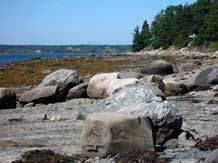What happens to shells when we crush them?
1. Ask the question

Let students know they are nearing the end of their work with earth materials. In this last part of their study, they will investigate what happens when natural forces change earth materials.
Have students close their eyes for a moment and then call up a couple of different scenarios.
- Imagine you are standing on top of a mountain, and you can stand there for millions of years. The wind blows, the rain comes down, water freezes and thaws. Gradually the mountain wears away. Where does it go? How much is left? Does it actually disappear?
- Imagine you are the ocean, pounding against the cliffs in some faraway place. You are a wild ocean, and you pound away for thousands of years. What happens to the rocks? To the sand? To the soil? Where does it go? How much is left? Does it actually disappear?
Listen to the answers, and remind students that they learned a word for this kind of "wearing away" of earth materials earlier in the unit. The process is called weathering and it takes a very, very long time. As earth materials weather, they break into smaller and smaller pieces — like the tiny bits of mica and quartz students saw in their rocks a couple of weeks back. Now pose a new scenario.
- Imagine you have a bag full of shells and you smash them all to bits, like a giant wave or a big wind, but working much faster. What happens to the shells? What changes? What remains the same?
- Does the weight change? Does the volume? What about the material itself?
Point out the investigation question:
What happens to shells when we crush them?
Let students know they are about to find out for themselves.



